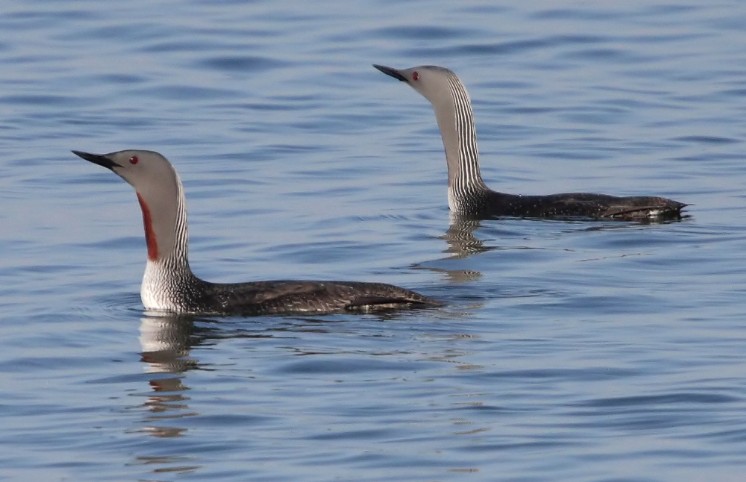Red-throated Diver-Update
Reports

The Red-throated Diver is the smallest of the UK's divers. Its grey-brown plumage and up-tilted bill readily distinguish it from the other species. In summer it has a distinctive red throat. Like other divers, it has been known to stay underwater for up to a minute and a half. With webbed feet at the end of powerful legs, it is a skilled underwater hunter, but with legs set well back on its body, it is very ungainly on land, only coming ashore to breed. A circumpolar breeder from the high Arctic south to the northern temperate zone, Scotland is at the extreme southern edge of its breeding range. Shetland is the Scottish stronghold with almost half the Scottish breeding population there.
Arran is the most southern breeding area in Scotland for this special bird….but for how much longer? Red-throated Divers breed on remote moorland lochans and are increasingly being disturbed on Arran by humans, probably inadvertently. Appropriately licensed observers checking remote lochans this year on Arran found no evidence of successful breeding. They did find evidence of camping and mountain bikes as well as dogs. At a less remote lochan the Arran Access Trust supported by the Arran Natural History Society put up notices informing people of the presence of divers, asking for care to be taken but to no avail. There was again no evidence of successful breeding.
If you do come across Red-throated Diver on a lochan please give the lochan a wide berth. Do not hang around. Keep dogs on a lead. Even a short time off the nest means the eggs are vulnerable to predators like crows and gulls. The best breeding season for Red-throated Diver in recent years was 2012 when the miserable wet summer reduced the number of humans around these lochans.
Although Red-throated Divers breed on the hill lochans, they feed on the sea and in winter are almost completely maritime. Round the coast of Arran, they have been recorded in every month of the year. Back in their breeding areas by late March, clutches of almost invariably two eggs are laid from early May through to June, with birds fledging in early August. The young are first fed on the lochan by the adults and after the young fledge, the adults continue to feed them on the sea. The late summer and autumn are good times to look out for family groups in our sheltered bays. Not sure how many, if any, young will be seen on the sea this year.
An old name for this bird is Rain Goose For example, in Shetland this bird is considered one of the best weather indicators, short cries or flying inland indicated fine weather, long, plaintive ones or flying out to sea wet weather. Whether there is any truth in this or not, their distinctive plaintive call as they fly to and from their feeding grounds in the sea is a feature of Arran…but for how much longer?
Although Red-throated Divers breed on the hill lochans, they feed on the sea and in winter are almost completely maritime. Round the coast of Arran, they have been recorded in every month of the year. Back in their breeding areas by late March, clutches of almost invariably two eggs are laid from early May through to June, with birds fledging in early August. The young are first fed on the lochan by the adults and after the young fledge, the adults continue to feed them on the sea. The late summer and autumn are good times to look out for family groups in our sheltered bays. Not sure how many, if any, young will be seen on the sea this year.
An old name for this bird is Rain Goose For example, in Shetland this bird is considered one of the best weather indicators, short cries or flying inland indicated fine weather, long, plaintive ones or flying out to sea wet weather. Whether there is any truth in this or not, their distinctive plaintive call as they fly to and from their feeding grounds in the sea is a feature of Arran…but for how much longer?
Organisations and individuals on Arran are trying to manage human disturbance for the benefit of our wildlife. The Red-throated Diver is but one example. Information on websites, in leaflets and on notices in line with the legislation in the Scottish Outdoor Access Code are available from Visit Arran, Arran Access Trust and others. There is a genuine attempt to try to protect our wildlife while giving appropriate access for humans. Hopefully those who love Arran will support this and help to ensure that Arran retains its wildlife, because without its wildlife, Arran will be a much poorer place.

